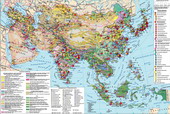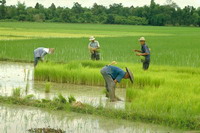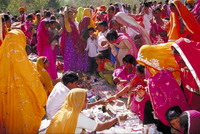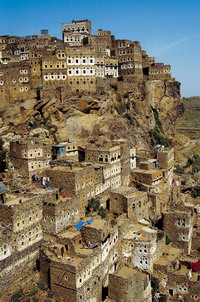Asia - the largest part of the world. It is home to more than half of humanity. At its infinite spaces have ancient civilization with a high material and spiritual culture, originated here three world religions, and now form the specific model of socio-economic development: Japan, China, development model of Petroleum Exporting Countries, etc.
In terms of economic development, most states included in the group of developing countries, only Japan and Israel are classified as highly. North Korea, Vietnam and China belong to the group of countries with centrally-managed economies. The Caucasus and Central Asia - the state economy in transition.
For economy of most countries in Asia characteristic is the predominance of agriculture over industry, and agriculture is dominated by crop production.
for industry (excluding Japan, China, Kazakhstan, NIS) is characterized by the dominance of extractive industries on manufacturing.
in the international division of labor in Asia, with the exception of developed countries, are suppliers of agricultural products (tea, natural rubber, cotton, spices, tropical and subtropical fruits) as well as products of mining and extractive industries (oil, gas , manganese, tin, chromite, iron ore, etc.).
South West Asia - most of the Middle East (from Turkey to Afghanistan and the island of Cyprus), this includes 16 independent states and the Palestinian territories. This region is called the crossroads, as it is located at the crossroads of Europe, Asia, Africa, the crossroads of major shipping routes. This situation and the availability of oil (2 / 3 of world reserves) and gas (1 / 4 of world reserves) increase the economic and strategic importance of the region.
region's economy is mainly agrarian and raw materials. In the main oil-producing countries and on the nature of the economy depends on the production and marketing of oil and gas (Iraq, Iran, Bahrain, Kuwait, Oman, Qatar, UAE, Saudi Arabia). In some states developed oil refining industry, certain branches of engineering and metalworking (Israel, Iraq, Jordan, Kuwait, Turkey). Problems of South-West Asia are water shortages and political instability.
South Caucasus - are located in the southern part of the Caucasian isthmus (Armenia, Azerbaijan, Georgia). According to its geographical position they belong to Asia, but on the historical development and cultural traditions (Georgia and Armenia - the Christian countries), some scientists consider them to European countries. These states maintain close ties with both the Central and Eastern Europe and countries of South-West Asia. Caucasus is rich in fuel and energy resources (Azerbaijan), iron ores (Armenia), manganese ores (Georgia), copper ores (Armenia and Georgia). This region is known as a resort and as specialized in growing vegetables, fruits, citrus, grapes and tea.

Central Asia. This region includes Mongolia, Kazakhstan and Central Asian countries - Turkmenistan, Uzbekistan, Kyrgyzstan, and Tajikistan. They are located in the Closed Drainage of Eurasia, in the desert and semi-deserts. One of the main problems of the region is a significant shortage of water. Countries in the region is well provided with some kinds of mineral resources: coal (Kazakhstan), oil and natural gas (Kazakhstan, Turkmenistan, Uzbekistan), ores of nonferrous metals (Kazakhstan, Uzbekistan), and chemical raw materials. Extractive industry is leading the industry in most countries. In the economic complex of Kazakhstan are allocated metallurgy, chemical industry, machine building, light and food industries. Agriculture in the region specializing in growing grain and cotton, dairy and beef cattle breeding, horse breeding (Mongolia).
to Southeast Asia include Indochina Peninsula, Malay Archipelago and the Philippine Islands. In this region - 11 countries: Myanmar, Vietnam, Laos, East Timor, Thailand, Cambodia, Malaysia, Brunei, Indonesia, Singapore. Through Southeast Asia are the way from Europe and the Middle East to East Asia and Australia. Countries in the region is well provided with natural resources, have a strong export base and become the largest and sometimes monopoly exporter of certain goods (consumer electronics, telecommunications equipment, integrated circuits, etc.).
Southeast Asia continues to serve as an important supplier MGRT agricultural commodities (rice, natural rubber, spices, coconuts, palm oil). Countries in the region (especially Indonesia, Malaysia, Singapore, Philippines), world leaders in terms of attracting investment.
South and East Asia are presented on separate cards. Separate group in Asia are the new industrializing economies (NIEs) of Southeast and East Asia. These include the four Asian tigers, which have risen on the first wave of industrialization of the 80's. Twentieth century. (South Korea, Singapore, Hong Kong, Taiwan), and the country's second wave of industrialization of the 90-ies. Twentieth century. (Malaysia, Thailand, Brunei, Indonesia, Philippines). Back in the mid-twentieth century. the role of these countries in the world economy was minor, but over time they began to actively and consistently implement a policy of industrialization on the Japanese model, and with financial assistance from Japan and the U.S.. In the NIS was established economies open to free economic zones and export-oriented industries. Over the past decade has increased significantly the share of industry in the GNP continues to increase the share of services, indicating the approximation of these countries to be developed. Thus, the reason economic takeoff NIEs of Southeast and East Asia were the restructuring economy with widespread introduction of scientific and technological progress.
 English
English






















